 W
WL'Absinthe is a painting by Edgar Degas, painted between 1875 and 1876. Its original title was Dans un Café, a name often used today.
 W
WThe Apparition (French: L'Apparition) is a painting by French artist Gustave Moreau, painted between 1874 and 1876. It shows the biblical character of Salome dancing in front of Herod Antipas with a vision of John the Baptist's head. The 106 cm high and 72,2 cm wide watercolor held by the Paris Musée d'Orsay elaborates an episode told in the Gospel of Matthew 14:6–11 and Mark 6:21–29. On a feast on the occasion of Herod Antipas' birthday, the princess Salome dances in front of the king and his guest, pleasing him so much he promises her anything she wished for. Incited by her mother Herodias, who was reproved by the imprisoned John the Baptist for her illegitimate marriage to Herod, Salome demands John's head in a charger. Regretful but compelled to keep his word in front of his peers, Herod fulfills Salome's demand. John the Baptist is beheaded, the head brought in a charger and given to Salome, who gives it to her mother.
 W
WBal du moulin de la Galette is an 1876 painting by French artist Pierre-Auguste Renoir. It is housed at the Musée d'Orsay in Paris and is one of Impressionism's most celebrated masterpieces. The painting depicts a typical Sunday afternoon at the original Moulin de la Galette in the district of Montmartre in Paris. In the late 19th century, working class Parisians would dress up and spend time there dancing, drinking, and eating galettes into the evening.
 W
WBoating is an 1874 painting by French artist Édouard Manet in the collection of the Metropolitan Museum of Art, New York.
 W
WBreezing Up is an oil painting by American artist Winslow Homer. It depicts a catboat called the Gloucester chopping through that city's harbor under "a fair wind". Inside the boat are a man, three boys, and their catch.
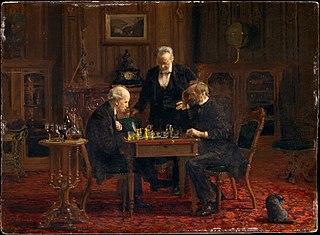 W
WThe Chess Players is an 1876 genre painting by Thomas Eakins, Goodrich catalogue #96. It is in the collection of the Metropolitan Museum of Art.
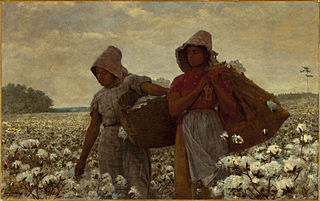 W
WThe Cotton Pickers is an oil painting of 1876 by Winslow Homer. It depicts two young African-American women in a cotton field. Stately, silent and with barely a flicker of sadness on their faces, the two black women in the painting are unmistakable in their disillusionment: they picked cotton before the war and they are still picking cotton afterward.
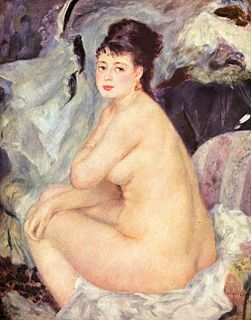 W
WFemale Nude is an 1876 painting by Pierre-Auguste Renoir, also known as Nude Woman Sitting on a Couch, Anna, After Bathing and Pearl.
 W
WFlooding at Port-Marly is the title of two series of paintings by Alfred Sisley, produced at Port-Marly in 1872 and 1876. Two works from the 1876 series are now in the Musée d'Orsay, with one hanging in the museum itself and the other at the Musée des beaux-arts de Rouen.
 W
WA Girl with a Watering Can is an 1876 Impressionist painting by Pierre-Auguste Renoir. The work was apparently painted in Claude Monet's famous garden at Argenteuil, and may portray one of the girls in Renoir's neighborhood in a blue dress holding a watering can.
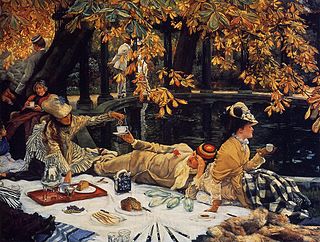 W
WHolyday, later also known as The Picnic, is an oil painting by French painter James Tissot (1836–1902), painted in 1876. Tissot moved to England in the year 1871, when he was thirty five years old and settled there. Before moving to London, Tissot was a successful painter of Paris society.
 W
WLa Japonaise is a 1876 painting by the French impressionist painter, Claude Monet.. The full-length portrait depicts a European woman in a red kimono standing in front of a wall decorated by Japanese fans. Monet's first wife Camille Doncieux modeled for this painting.
 W
WMorning Ride on the Beach is an 1876 painting by Dutch artist Anton Mauve from the Hague School. It shows a group of riders on the Scheveningen beach, painted in an impressionistic style. The work is now in the collection of the Rijksmuseum in Amsterdam.
 W
WMother and Children is an Impressionist painting by Pierre-Auguste Renoir that is housed in the Frick Collection. Although the painting is most commonly known as Mother and Children, Renoir presented it with the title La Promenade in 1876. The painting is displayed in an alcove under a set of stairs at the Frick.
 W
WNero's Torches is an 1876 painting by the Polish artist Henryk Siemiradzki. It is also known as Candlesticks of Christianity. It depicts a group of early Christian martyrs who are about to be burned alive as the alleged perpetrators of the Great Fire of Rome, during the reign of emperor Nero in 64 AD. People from many different social spheres, including the emperor himself, are present to watch the burning, which takes place in front of the Domus Aurea. The motif is based on the descriptions by Suetonius and Tacitus.
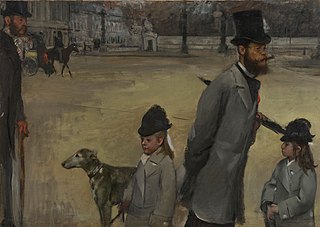 W
WPlace de la Concorde or Viscount Lepic and his Daughters Crossing the Place de la Concorde is an 1876 oil painting by Edgar Degas. It depicts the cigar-smoking Ludovic-Napoléon Lepic, his daughters, his dog, and a solitary man on the left at Place de la Concorde in Paris. The Tuileries Gardens can be seen in the background, behind a stone wall.
 W
WPlace du Chenil in Marly, Snow Effect is an 1876 oil on canvas painting by Alfred Sisley. It is now in the Musée des beaux-arts de Rouen, to which it was given by François Depeaux in 1909 It was painted at Marly-le-Roi and a lifesize reproduction of it is on display near the site of its creation as part of the Pays des Impressionnistes trail.
 W
WLe Pont de l'Europe is an oil painting by French impressionist Gustave Caillebotte completed in 1876. It is held by the Musée du Petit Palais in Geneva, Switzerland. The finished canvas measures 125 by 181 centimetres.
 W
WPortrait of Marguerite de Conflans is a c.1876 oval oil on canvas portrait by the French painter Édouard Manet. It is owned by the Musée d’Orsay, though it is on display in the red salon at the Musée des Augustins in Toulouse. Like A Bar at the Folies-Bergère, the work mimics Ingres in its use of a mirror to show the figure from several angles, a motif rarely used by Manet.
 W
WPortrait of Stéphane Mallarmé is an 1876 oil on canvas portrait by Edouard Manet of his friend, the poet Stéphane Mallarmé. It is now in the Musée d'Orsay, which was acquired from the subject himself.
 W
WSalome Dancing before Herod is an oil painting produced in 1876 by the French Symbolist artist Gustave Moreau. The subject matter is taken from the New Testament, depicting Salome—the daughter of Herod II and Herodias—dancing before Herod Antipas.
 W
WThe Seine at Bougival is an 1876 painting by Alfred Sisley, now in the Impressionist section of the Metropolitan Museum of Art, which acquired it in 1992 as a promised and partial gift of Mr and Mrs Douglas Dillon. It shows part of the Seine near Bougival.
 W
WShakuntala Patra-lekhan is an 1876 painting by Raja Ravi Varma. The work depicts Shakuntala laying on grass, writing a letter to her lover Dushyanta. The work had won praise for Ravi Varma when it was presented at the Madras Fine Arts Exhibition of 1876. Later acquired by the Duke of Buckingham, the painting was subsequently used in the English translation of Kalidasa's Shakuntalam.
 W
WA Street in Marly or Place du Marché is an 1876 oil painting by Alfred Sisley, painted at Port-Marly and now in the Kunsthalle Mannheim. A lifesize reproduction of it is shown near the site of its creation as part of the Pays des Impressionnistes trail.
 W
WThe Studio Boat is a painting done in the impressionist style in 1876 by the French artist Claude Monet. The work was executed en plein air in oil on canvas with a size of 72 by 60 cm and currently belongs in the collection of the Barnes Foundation of Philadelphia.
 W
WThe Swing is an 1876 oil on canvas painting by the French artist Pierre-Auguste Renoir who was a leading exponent of the Impressionist style. The painting measures 92 x 73 centimetres and is in the Musée d’Orsay. Renoir executed the painting in what are now the Musée de Montmartre gardens. He had rented a cottage in the gardens so that he could be closer to the Moulin de la Galette where he was engaged in painting Bal du moulin de la Galette.
 W
WA Visit from the Old Mistress is an 1876 painting by American artist Winslow Homer. It was one of several works that Homer created during a mid-1870s visit to Virginia, where he had served as a war correspondent during the Civil War. Scholars have noted that the painting's composition is taken from Homer's earlier painting Prisoners from the Front, which depicts a group of captive Confederate soldiers defiantly regarding a Union officer. It, along with Homer's other paintings of black southern life from this period, have been praised as an "invaluable record of an important segment of life in Virginia during the Reconstruction."
 W
WThe Watering Trough at Marly with Hoarfrost is an 1876 painting by Alfred Sisley. It was owned by François Depeaux, a Sisley collector, and passed through other collections before ending up in that of Paul Mellon. It is now in the Virginia Museum of Fine Arts in Richmond, United States.
 W
WWilliam Rush and His Model is the collective name given to several paintings by Thomas Eakins, one set from 1876–77 and the other from 1908. These works depict the American wood sculptor William Rush in 1808, carving his statue Water Nymph and Bittern for a fountain at Philadelphia's first waterworks. The water nymph is an allegorical figure representing the Schuylkill River, which provided the city's drinking water, and on her shoulder is a bittern, a native waterbird related to the heron. Hence, these Eakins works are also known as William Rush Carving His Allegorical Figure of the Schuylkill River.